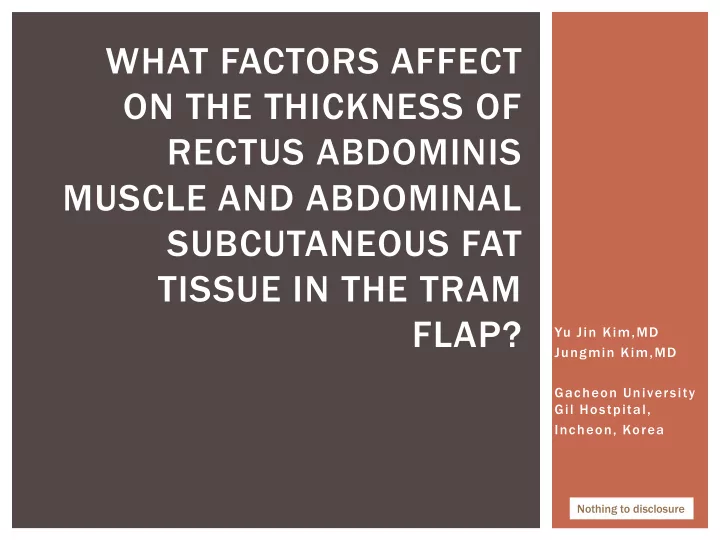

WHAT FACTORS AFFECT ON THE THICKNESS OF RECTUS ABDOMINIS MUSCLE AND ABDOMINAL SUBCUTANEOUS FAT TISSUE IN THE TRAM FLAP? Yu Jin Kim,MD Jungmin Kim,MD Gacheon University Gil Hostpital, Incheon, Korea Nothing to disclosure
BACK GROUND Rectus abdominis muscle flap is widely using method for reconstruction for large defect. When the pedicled TRAM flap is considered for reconstruction, an extremely thin muscle pedicle can cause circulation problems. We have an experience of very thin rectus abdominis muscle during the TRAM flap.
OBJECTIVE OF THE STUDY For safe elevation of TRAM or VRAM For effective volumetric coverage of the defect To evaluate as follows The thickness of the abdominal subcutaneous fat The thickness of the Rectus Abdominis muscle
METHOD A total of 545 adult women Age range, 20 to 60 years Abdomino Pelvic CT : thickness of rectus abdominis muscle and abdominal subcutaneous fat Review of medical record: age, number of pregnancy, history of laparotomy, and BMI.
LEVEL OF MEASUREMENT
RESULT 1. GESTATIONAL HISTORY AND LAPAROTOMY
RESULT 2. THICKNESS OF THE RECTUS MUSCLE AND THE SUBCUTANEOUS FAT MXR: Thickness of right muscle at xiphoid level MXL: Thickness of left muscle at xiphoid level MUR: Thickness of right muscle at umbilicus level MUL: Thickness of left muscle at umbilicus level FUR: Thickness of subcutaneous fat tissue of the right side at umbilicus level FUL: Thickness of subcutaneous fat tissue of the left side at umbilicus level
RESULT 3.PEARSON’S CORRELATION COEFFICIENT OF VARIOUS FACTORS MXR, thickness of right muscle at the xiphoid level; MXL, thickness of left muscle at the xiphoid level; MUR, thickness of right muscle at the umbilicus level; MUL, thicknessof left muscle at the umbilicus level; FUR, thickness of subcutaneous fat tissue on the right side at the umbilicus level; FUL, thickness of subcutaneous fat tissue on the left side at the umbilicus level; G, number of gestations; P, number of pregnancies; AA, number of artificial abortions; SA, number of spontaneous abortions; ND, number of normal deliveries; CS, number of Cesarean sections; L, number of laparotomies; BMI, body mass index. a)P<0.05.
RESULT 4. SCATTERED DIAGRAMS OF THE CORRELATION WITH AGE Negative correlations between age and muscle thickness in all levels . The thickness of fat tissue ; not influenced by the age.
CONCLUSION Rectus abdominis muscle became thinner with aging. Age, gestational history, and history of laparotomy influenced rectus abdominis muscle thickness but did not influence abdominal subcutaneous fat thickness. These results are clinically valuable for planning a rectus abdominis muscle flap and safe elevation of muscle flap.
Recommend
More recommend